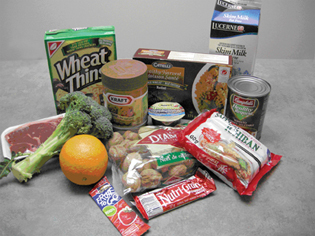Module 1
1. Module 1
1.9. Page 2
Module 1—Thinking Energy
 Explore
Explore
 Try This
Try This
Ranking Foods by Their Energy Content

Step 1: Find at least ten foods in your home.
Step 2: Predict the amount of energy contained in one serving of each food by ranking the foods from highest to lowest energy content.
Step 3: Use the nutrition label or the Internet to determine the energy content of each food. If the energy content is given in calories, multiply the number of calories by 4.19 and record the value as kilojoules (kJ) in your table.
Analysis
TR 1. Calculate the energy content per gram for each food. Rank the foods from highest to lowest energy content per gram.
TR 2. Compare your ranking of predicted energy content with your ranking based on calculated values. Explain any differences.
 Read
Read
calorimeter: an isolated system in which the chemical system being studied is surrounded by a known quantity of liquid
calorimetry: the technological process of measuring the energy changes of an isolated system
How is the energy content of food determined? Read pages 485–489 in the textbook to learn more about a calorimeter and calorimetry.
 Watch and Listen
Watch and Listen
To understand how thermochemistry is used to determine the quantity of energy available in food, read “Food Energy.” This is a transcript of an audio clip available on the website for the textbook. To listen to the audio clip, go to www.science.nelson.com and follow the links to Unit 6, Chapter 11, Section 11.2, Extension. You may need to ask your teacher for a username and password to access the audio clip.
In the audio clip and transcript, reference is made to a more sophisticated type of calorimeter, a bomb calorimeter. View the animation “The Oxygen Bomb Calorimeter” for more information about a bomb calorimeter.